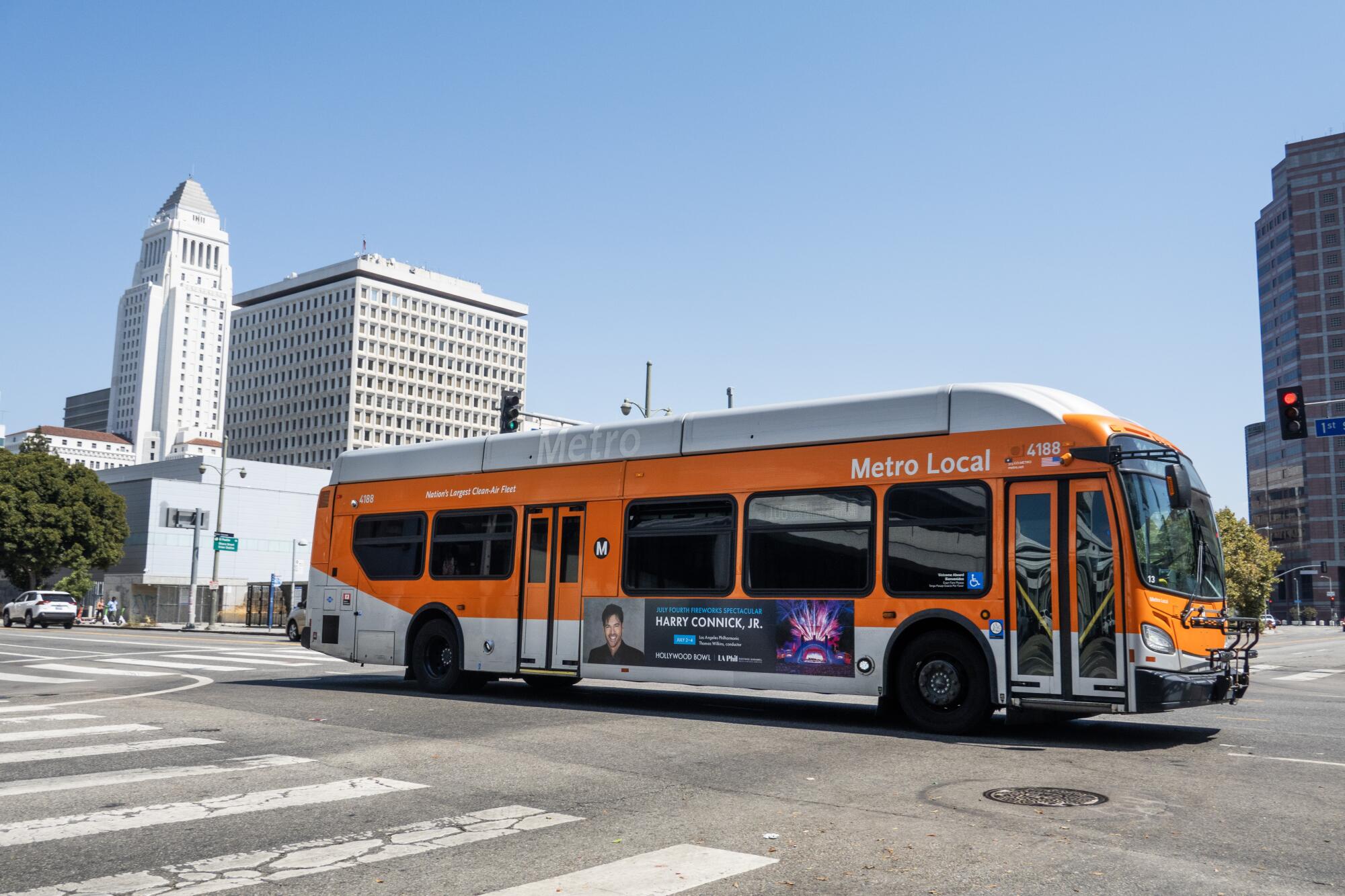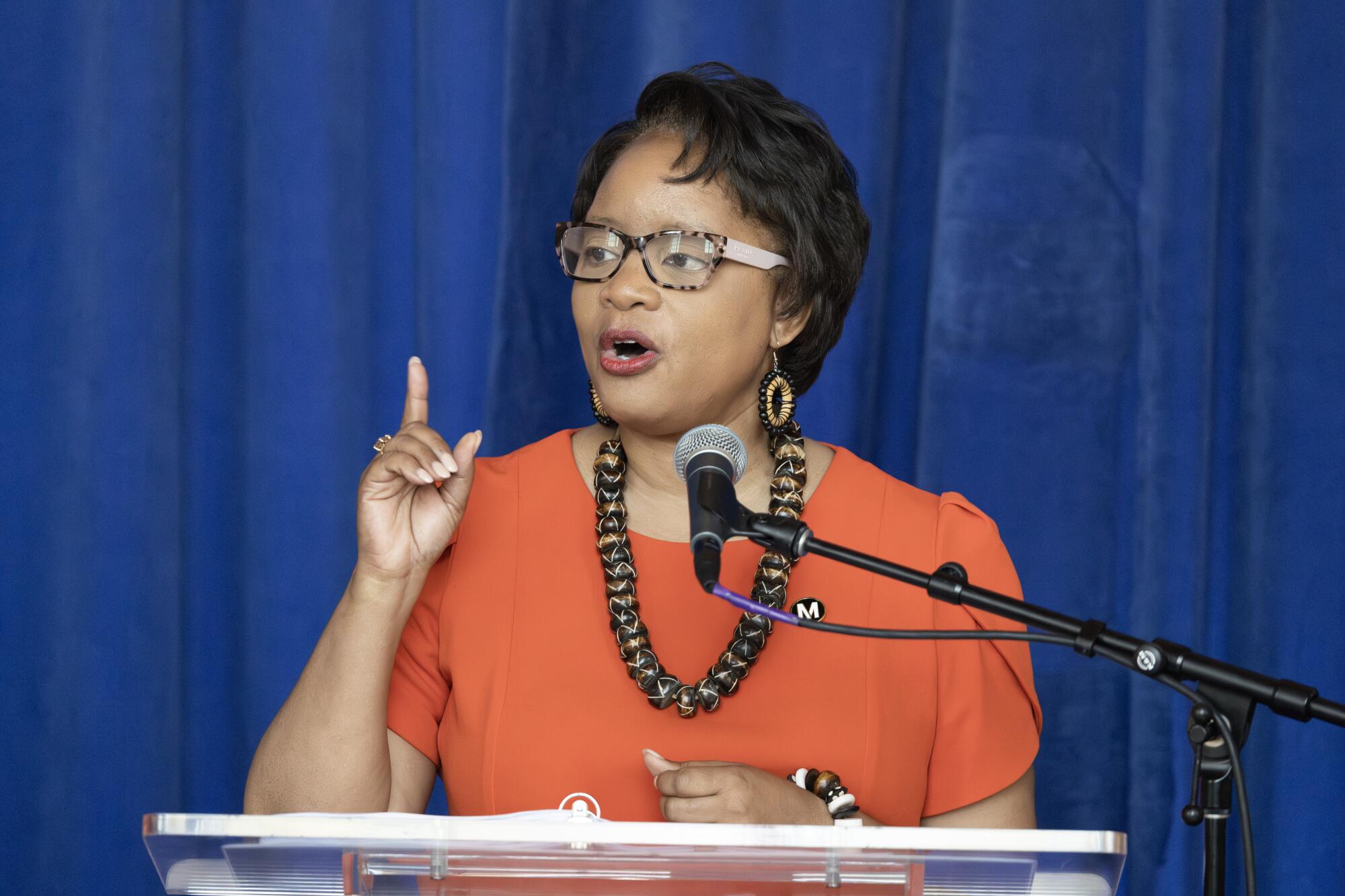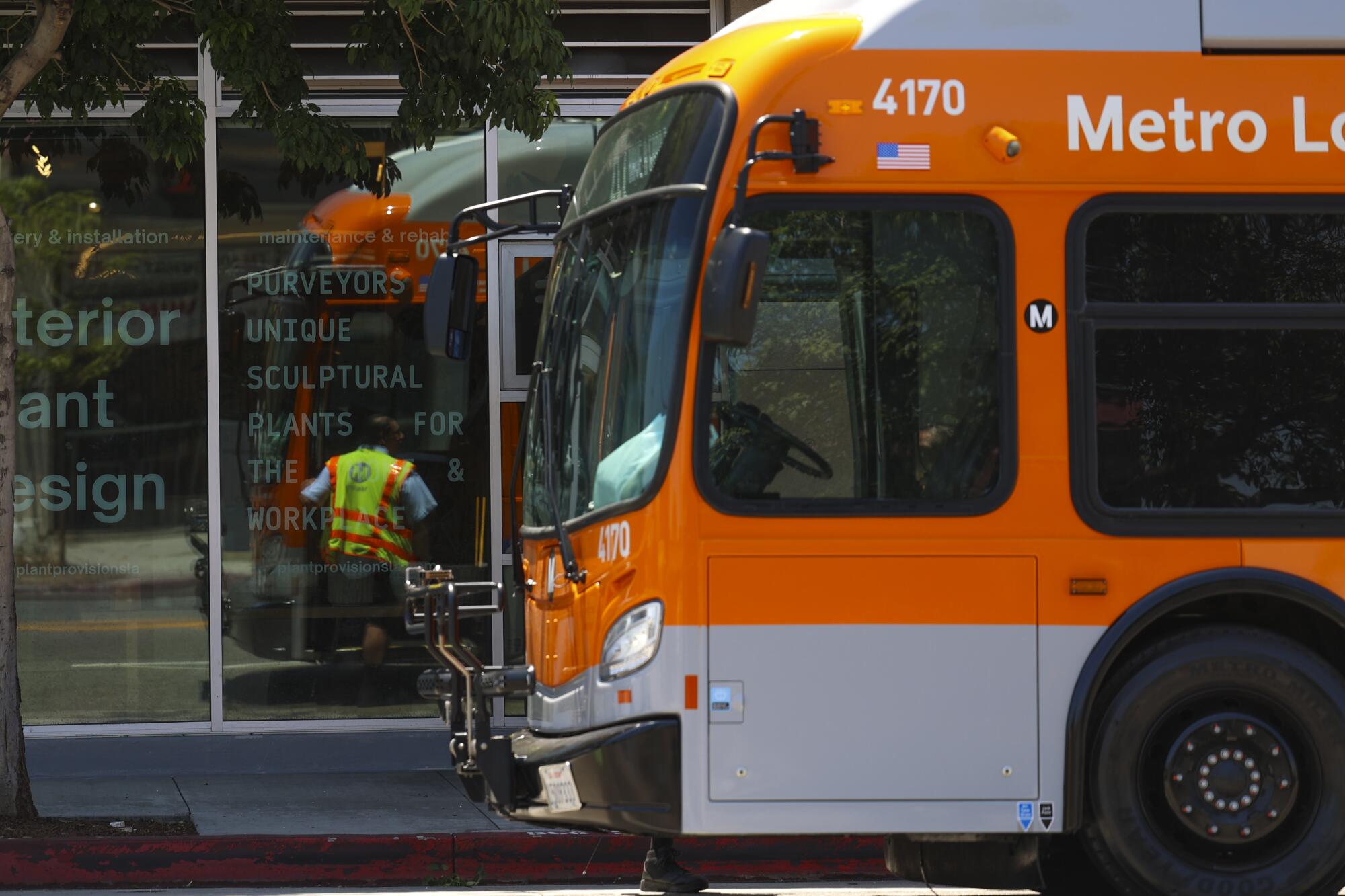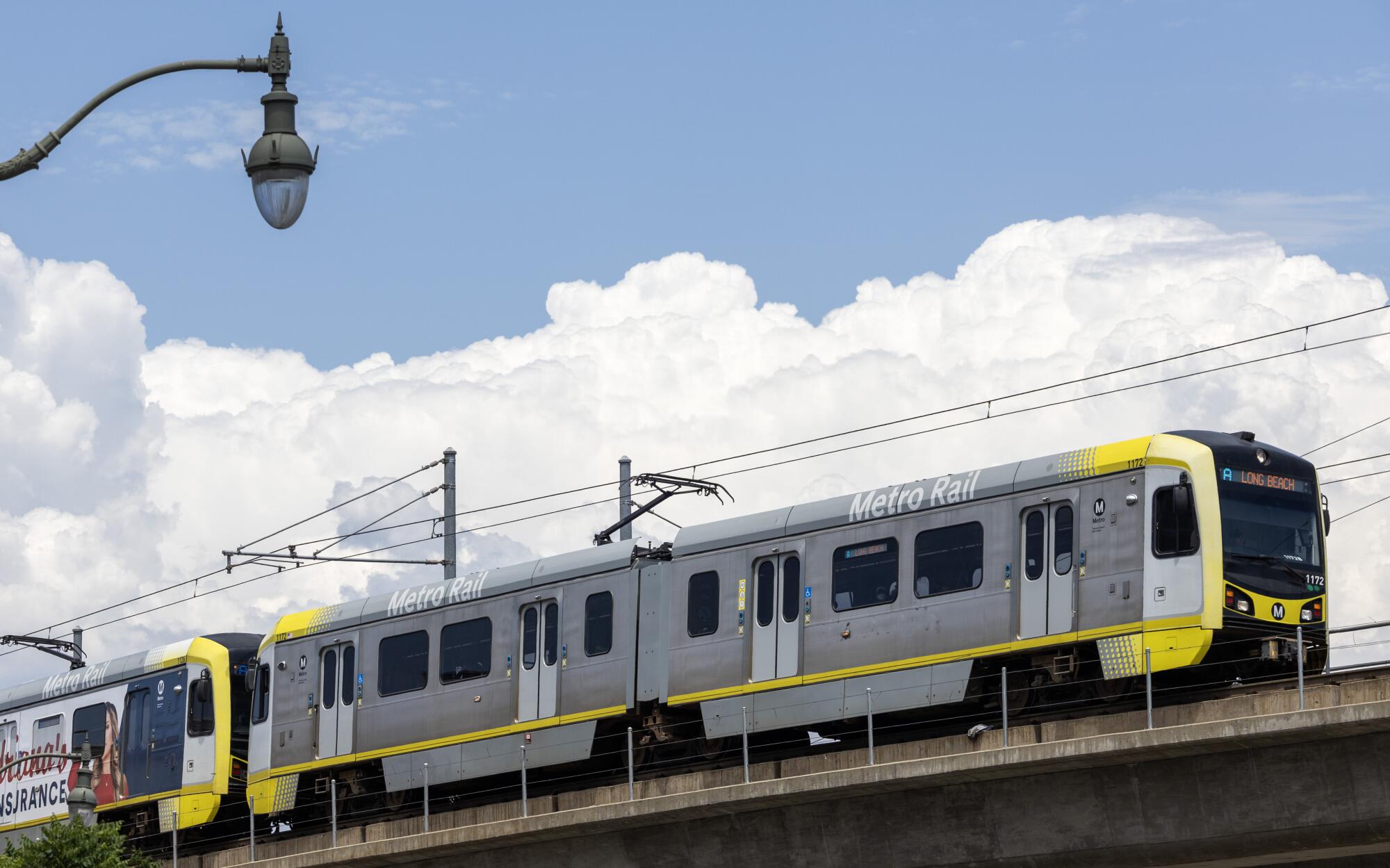
- Share via
When a homeless man with an airsoft gun hijacked a Metro bus, careened into several cars and crashed into the Ritz Carlton last March, Metro’s top security officer at the time, Gina Osborn, called Metro Chief Executive Stephanie Wiggins. It was around midnight and there was no answer. She texted her and then called Wiggins’ top aide, Nicole Englund.
“This bus just got hijacked, I’m giving you all the details,” she said.
Startled, Englund offered to call Wiggins herself. By the next day, Osborn said, she hadn’t heard back from either of them.

This behind-the-scenes glimpse of the hijacking is described in a lawsuit filed this week, alleging that Osborn later was wrongfully terminated for raising concerns about how law enforcement agencies were patrolling the Metro system. The complaint lays bare the tension between Osborn and Wiggins at a time when public safety had become the agency’s most public problem.
In leading the $9-billion agency, one of Wiggins’ biggest challenges has been making passengers — many of whom confront the region’s homelessness, crime and drug use problems during their daily commutes — feel safe.
Her point person was Osborn, a former FBI agent, but the two were increasingly at odds. Communications between the women broke down so badly, according to Osborn, that they didn’t meet one-on-one for two months and Osborn regularly saw a “trust” coach whom Wiggins had brought in to help the agency.

A week after the hijacking, Osborn was fired.
In the lawsuit, her lawyer argued that the move was in retaliation for Osborn having filed an inspector general’s report three days earlier that accused sheriff‘s deputies of abandoning their post for what she suspected was a fundraiser. The inspector general reports to the Metro board.
Wiggins, according to Osborn, keeps tight control over information released to the board and was infuriated and fired her in retaliation.
Until then, Osborn said, she had not received any disciplinary action during her two-year tenure.
The lawsuit describes a tense relationship between the two, fueled by diverging views about how Metro’s sprawling system should be secured. It also hints at a sometimes contentious relationship between Osborn and the law enforcement agencies charged with patrolling it.
Wiggins declined to comment on the pending litigation, but in an emailed statement said: “As the leader of this organization, who carries this immense responsibility, I demand the highest standards from my leadership team.”
She said that on the night of the hijacking, “the emergency response team worked as intended.”

Metro’s safety team “is empowered to make in-the-minute decisions” and leadership is “trained and authorized to make those decisions during a crisis,” she wrote.
According to Metro spokeswoman Pamela Krebs, the office of the county counsel — which has a lawyer who reports directly to the Metro board — said in a statement that Osborn’s allegations had been independently investigated and found “not supported by the facts.” The statement went on to say, “We feel very strongly about Metro’s ability to prove its case in court.” Krebs said Metro had not yet obtained the lawsuit.
Osborn’s lawsuit accuses Wiggins of creating a hostile work environment and berating and talking down to her, alleging that Wiggins left her out of critical safety meetings and closely monitored any communication she had with board members or their deputies.
Her lawyers are seeking $7 million in damages, retirement benefits and reinstatement of her position.
The Times talked to more than half a dozen former executives who said they had similar experiences and that Wiggins injected fear among staffers, belittled people and iced out critics. Several requested anonymity because they still work in transportation or have business with the agency and don’t want ruin their relationships.
Others, however, supported her approach — saying Wiggins pushed employees in order to raise the bar. Inside the agency, they said, she is known for a relentless work ethic and holding her team to high standards. She can be meticulous about detail, digging into the weeds in areas other executives might leave to staff.
One of her first big operational efforts was an overhaul of Metro’s bus routes called NexGen.
Several former employees recall her holding online meetings at 7 a.m. for weeks to discuss details of the rollout. The system was getting an overhaul as the pandemic was easing and there were thousands of bus-stop signs, routing schedules and digital platforms that needed to be changed.
When she didn’t like the way things were going, they said, she threatened to hold meetings earlier because the 7 a.m. timing “wasn’t punishment enough.”

“For those of us who had not previously worked closely with her, it was shocking to be treated that way in a professional environment,” said a former employee who was on those calls.
Conan Cheung, head of operations who was at those meetings, saw things differently. He said Wiggins challenged employees to think out of the box, to do things differently.
“She is going to ask questions and if you can’t answer it, she keeps asking. But if you can, she moves on,” he said.
Some former Metro executives said subordinates bristled at her management style.
“Stephanie is more or less feared by a lot of folks in the upper management ring,” said Robert Bonner, Metro’s chief people officer from January 2022 to June 2023. In his position, he oversaw employee and labor relations including recruitment and human resources. He was also in charge of IT departments encompassing everything from geolocators on buses to internal networks.
“If you disagreed with her on an issue then you found yourself in a precarious position,” he said.
In one meeting with other top executives and managers, Bonner said, Wiggins intensely drilled a staffer whose recommendation she disagreed with. The employee was so shaken afterward that they sought an executive coach to help navigate the relationship. “Despite providing researched and well-reasoned recommendations, top managers were verbally insulted in front of their colleagues,” he said. “It had a profound impact on morale.”
Arnold Hackett, the chief financial officer at Metrolink whom Wiggins had brought in to look at processes when she was in charge of the commuter rail agency, said he didn’t have such experiences.
“I enjoyed the relationship because she was very direct at what she was asking, so I didn’t have ambiguity. She heard me out and listened too, so that we could talk about expectations.
“She had high expectations for the quality of work that she was expecting me to deliver,” he said. “Maybe that’s not sort of the environment for everyone.”
Metro’s chief customer experience officer, Jennifer Vides, said she followed Wiggins over from Metrolink.
“I was diagnosed with cancer and did 24 rounds of chemo plus two surgeries, yet four weeks later chose to follow her to Metro. Why? I admired her clear vision and genuine desire to improve transit,” she said. “Her strong work ethic and high standards bring out the best in me and others, which ultimately benefits Metro and our customers.”
Wiggins — who reports to a 13-member board that includes Los Angeles’ mayor and the county supervisors — took over at Metro in 2021, just as the region began to crawl out of a pandemic that profoundly altered transit.
Ridership had cratered and, with the board looking at alternatives to armed law enforcement in the wake of the police murder of George Floyd in Minneapolis, passengers who had to rely on the system complained that it was filthy and unsafe.
“The homeless would wait at Pershing Square for the 4 a.m train to come through and they would just get on,” said Maureen Micheline, a retired transportation board deputy. “They would have sex on the train, they would urinate and defecate, and she had to clean that up. Ridership dipped. She was under tremendous pressure. She was trying to please everyone on the board, and it’s hard.”
While at Metro, Osborn had been critical of how the Los Angeles Police Department, the Los Angeles County Sheriff‘s Department and the Long Beach Police Department patrolled the system. She pushed for better fare enforcement and advocated for more in-house security officers.
She became increasingly bothered, she said, by inadequate cybersecurity at Metro, the ability of trespassers to access underground rail corridors and rooms — and by Wiggins’ dismissal of her concerns.

When CBS News reported last August on dangerous traces of drugs left by transients camped out in the station, the lawsuit said, “Wiggins was infuriated the conditions of the ancillary areas had become public knowledge.” She ordered Metro security to surge the area, and Osborn advised that more officers would need to be hired because the change would leave the bus and rail lines exposed. Wiggins eventually added more transit officers at a cost of $6 million.
When asked in May about whether Wiggins dismissed Osborn’s concerns about ancillary areas until the information was leaked to the media, Metro spokesperson Patrick Chandler said the “allegations are categorically false.”
For months before Osborn was fired, the relationship was clearly strained. In July 2023, according to the lawsuit, Wiggins told her during a one-on-one meeting she “was not honest” and did “not take accountability” for her actions.
Frustrated, Osborn said, she told Wiggins that “she felt like she came to work every day not knowing if she was going to be fired.” Osborn suggested they meet with a trust coach Wiggins had hired to work with senior executives. Five months later, the two met in Santa Barbara with the coach, arriving in separate cars.
When Wiggins was asked to share something she valued about Osborn, the lawsuit said, she responded: “If that’s what you came here for, you’re not going to get it.” Even though the two were to meet weekly one-on-one from then out, that didn’t happen.
“Ms. Wiggins was desperate to maintain an image that MTA has no security issues, and if there were security issues, Ms. Wiggins and her staff had the control to spin the news as they saw fit,” the lawsuit states.
The agency has continued to struggle with high-profile crimes. Among those in recent months: A 66-year-old woman was fatally knifed on her commute home from work, a bus driver was stabbed and a Metro security guard shot a man who tried to stab him.
In May, Los Angeles Mayor Karen Bass ordered a surge of police on the Metro system. But the increase wasn’t enough to decrease the number of crimes from the previous month.
More to Read
Sign up for Essential California
The most important California stories and recommendations in your inbox every morning.
You may occasionally receive promotional content from the Los Angeles Times.










